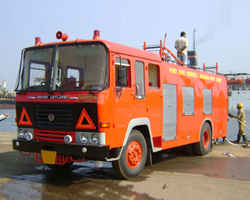
 - Fire Trucks
- Fire Trucks
Fire Fighting vehicles in India were a monopoly till early 1970s. Sensing the need to cater to this growing Industry, Garrison was formed with the aim to manufacture state of the art, modern, fire trucks and fire fighting equipments. Over the past 4 decades, GARRISON has created a niche in the field of manufacturing Fire Trucks.
GARRISON brand of Fire Fighting Vehicles are made using the best quality raw material. We do no compromise in the quality of our production. Our vehicles are fail-proof, provide ease of operation and have a very short response time. Our vehicles have been chosen by various Fire Fighting Organization for their quality and reliability during times of fire hazards.
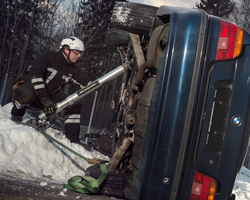
In comparison, hydraulic spreader-cutters are quieter, faster, stronger, and more versatile: they can cut, open, and even lift a vehicle. Nowadays, these hydraulic tools are not only used for vehicle crash rescues. These tools have the capacity to rescue victims trapped inside buildings devastated by fire or earthquake. Combinations of these tools are also used for Airplane crash rescue. RESQTEC is one of the oldest companies engaged in designing hydraulic rescue tools. Garrison is proud to be formally tied up with RESQTEC to cater to the growing needs of Hydraulic Rescue Equipments in the Indian market.
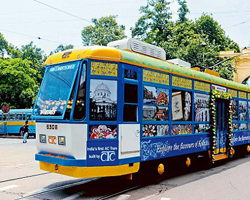
GARRISON & CTC - During the early 1990s, The Calcutta Tramways Co. introduced Bus services in Kolkata and suburbs. Garrison, as one of the leading Bus Body manufacturers, supplied many buses to the CTC. Through this relationship, and with an aim towards giving a modern look to the old-fashioned Tram coaches, Garrison began fabricating the contemporary tram coaches along with CTC. The City’s first AC Tram was fabricated by Garrison jointly with CTC.
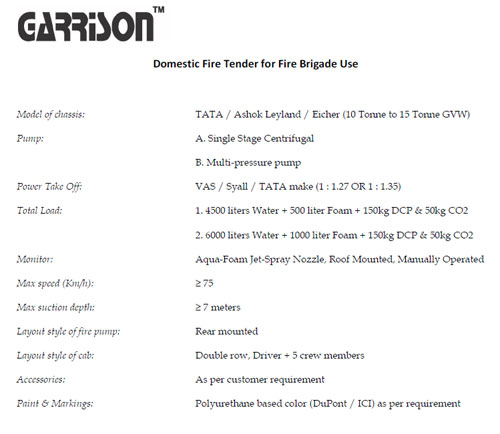
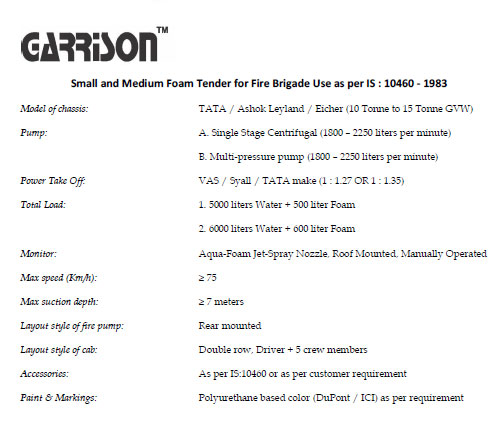
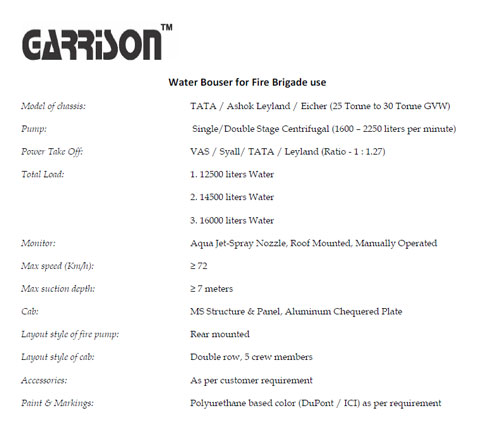
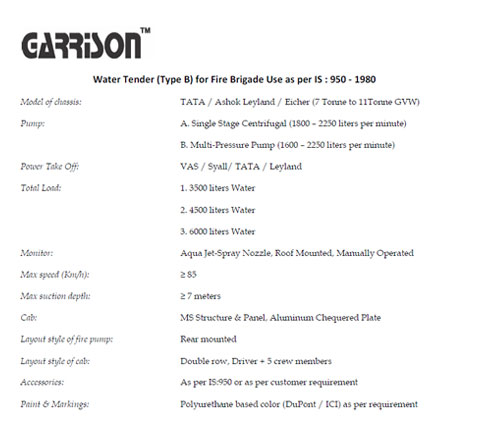
The Director General, WBF & ES, Kolkata
West Bengal Armed Police, Barrackpore
Indian Navy, Andaman & Nicober Islands
Sagardighi Thermal Power Project, West Bengal
Durgapur Thermal Power Project, West Bengal
South Eastern Railway, Garden Reach, Kolkata
The Director, KFF, Bangalore, Karnataka
Haldia Dock Complex, Kolkata Port Trust, Kolkata
Lafarge Cement, Meghalaya
MSP Metallics Ltd. Jharsuguda, Orissa
MSP Power & Steel, Raigarh, Chattisgarh
Eicher Motors Ltd., Kolkata
The General Manager, Metro Railway, Kolkata
Jindal India Ltd.
Pawan Hans Ltd.
Rahsmi Metalliks
Rashmi Cement
Orissa Metaliks
Rashmi Green Energy
Adani Green Energy
Mahan Energen
National Council of Science Museums
Health Department, Govt. of West Bengal
Firefighters are essential to the safety and security of our local communities.
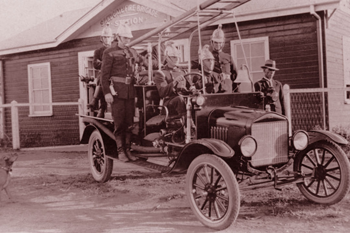 The lights, the sirens and the cascade of water, attributes of the modern day fire truck, have a tendency to hide the real role of this type of vehicles, that to save lives. For both kids and grown ups, the fuss created by a fire truck in action is thrilling beyond belief, outclassing its emergency services counterparts, the ambulances and the police cars. Today a common sight, the fire truck had to start somewhere. As was to be expected, motorized fire-fighting vehicles didn't come to be until the truck itself was invented. Yet, some of its today features have been around for some time now.
The very early fire engines were in fact water pumps on wheels. They were intended to come to the aid of those days' real firefighters, the so called "bucket brigades". This was back in the 1700s, when British built pumps began being used to put out fires in Europe and the US as well.
The first propulsion means for these pumps, whether they were hand or steamed powered, consisted of human beings pulling the pump. Being Fire crew from the early 1900s Fire crew from the early 1900scarried around by people, the apparatus had little room for personnel, they moved slowly and when they got to the scene, the firefighters were often too tired to do anything. Luckily, in most cases, the fires died out before they even got there, so there was little left for them to do.
Towards mid 1800s, the introduction of the paid firefighters made room for horses to be largely put to use and pull the fire pumps. This improved the response time of the fire brigades, but still didn't solve the firefighter transport issue. People literally ran to the fires and, despite the fact that the pump was already there, they had some resting to do before getting to it. The introduction of running boards and back steps later solved this problem as well.
The continuing development in fire fighting technologies made life a lot harder for the horses. The increase in weight of the fire engine slowly turned the horses as ineffective as the people were before them. Often, after half a mile, the travel speed would decrease dramatically. This called for a new means of propelling the engines.
The first self propelled, steam powered fire engine in the US came to be in 1841 and it was built in New York. Strangely enough. it didn't caught on. Fire fighters considered such a propulsion solution dangerous and unreliable. It took tens of years before the steam powered fire engines caught on.
The reign of the steam didn't last long. Despite the fact that steam powered fire engines were still in use, here and there, up until the 1920, motorized fire trucks became more and more common by 1910. Horse drawn or steam powered engines started being turned into fire trucks. By 1913, Ahrens-Fox Manufacturing Company from Cincinnati was the leading company when it came to the conversion.
The lights, the sirens and the cascade of water, attributes of the modern day fire truck, have a tendency to hide the real role of this type of vehicles, that to save lives. For both kids and grown ups, the fuss created by a fire truck in action is thrilling beyond belief, outclassing its emergency services counterparts, the ambulances and the police cars. Today a common sight, the fire truck had to start somewhere. As was to be expected, motorized fire-fighting vehicles didn't come to be until the truck itself was invented. Yet, some of its today features have been around for some time now.
The very early fire engines were in fact water pumps on wheels. They were intended to come to the aid of those days' real firefighters, the so called "bucket brigades". This was back in the 1700s, when British built pumps began being used to put out fires in Europe and the US as well.
The first propulsion means for these pumps, whether they were hand or steamed powered, consisted of human beings pulling the pump. Being Fire crew from the early 1900s Fire crew from the early 1900scarried around by people, the apparatus had little room for personnel, they moved slowly and when they got to the scene, the firefighters were often too tired to do anything. Luckily, in most cases, the fires died out before they even got there, so there was little left for them to do.
Towards mid 1800s, the introduction of the paid firefighters made room for horses to be largely put to use and pull the fire pumps. This improved the response time of the fire brigades, but still didn't solve the firefighter transport issue. People literally ran to the fires and, despite the fact that the pump was already there, they had some resting to do before getting to it. The introduction of running boards and back steps later solved this problem as well.
The continuing development in fire fighting technologies made life a lot harder for the horses. The increase in weight of the fire engine slowly turned the horses as ineffective as the people were before them. Often, after half a mile, the travel speed would decrease dramatically. This called for a new means of propelling the engines.
The first self propelled, steam powered fire engine in the US came to be in 1841 and it was built in New York. Strangely enough. it didn't caught on. Fire fighters considered such a propulsion solution dangerous and unreliable. It took tens of years before the steam powered fire engines caught on.
The reign of the steam didn't last long. Despite the fact that steam powered fire engines were still in use, here and there, up until the 1920, motorized fire trucks became more and more common by 1910. Horse drawn or steam powered engines started being turned into fire trucks. By 1913, Ahrens-Fox Manufacturing Company from Cincinnati was the leading company when it came to the conversion.
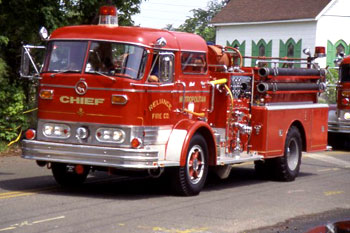 From 1911, Mack Trucks began producing fire trucks, slowly becoming the most famous manufacturer in this field.
Starting with the 1930s, the increasing sizes of the buildings called for a way for firefighters to reach the upper floors. Even if the concept of aerials was around since late 19th century, the ladder was taken to the next level during these years. It began being installed directly onto the trucks while the development of the turntable ladder made it possible for fire fighters to reach heights of up to 150 feet (46 m).
In the years following World War 2, fire trucks received the aerial work platform, which is nothing more than a bucket attached to a bending arm installed on a fire truck. The so called "cherry pickers" allow fire fighters to position the mechanical arm into unreachable corners of any building.
The modern day fire truck was defined towards the 1960s. The trucks now came with modern water pumps, ladders and "cherry pickers". A very important development was the introduction of the enclosed seats for the crew.
The modern day fire truck got specialized, so that it can perform different tasks, depending on the type of incident it responds to. Generally, they can be classified into three large categories: pumpers, turntable ladders and specialized fire trucks.
The pumpers (a.k.a. triple-combination pumpers) are the most common apparatus used by fire departments. Also know as wagons or engines, they are defined as being a type of vehicle permanently fitted with fire pump, water tank and hose body. The pumpers are used to provide its personnel with the tools required for the initial attack on the fire.
The turntable ladder, commonly know as ladder, is the specialized truck used to access fires occurring at higher levels. It helps provide access and egress of both firefighters and casualties, as well as providing a higher water point, in conjunction with a long hose. Most of the ladder trucks are pumpers as well. The ones fitted with a bucket on top of the hydraulic arm are called town ladders.
The tiller, or tractor drawn aerial, is a specialized ladder truck, with the ladder mounted on a semi-trailer. It has separate steering wheels for the front and rear wheels, making it ideal for narrow streets.
The hydraulic platform (a.k.a. articulating booms, Snorkels, platform truck or Bronto) is a type of ladder truck which in some cases comes equipped with an articulated hydraulic arm. This allows for the arm to extend up and over some obstacles like roof tops.
Water tenders are large water tanks on wheels, used to transport water to the scene of the fire. They are mostly used in rural areas, where hydrants are not usually found. Besides helping with fires, thanks to its pumps, it is used to draw in water from floods.
Wildland fire engines are, basically, the 4x4 of fire trucks (not a truck per se, though). It is used to fight fires in mountains and hills, where regular fire trucks are unable to go.
Crash tenders are fire trucks intended for fighting aircraft fires. They are, perhaps, the most complete fire trucks out there. They can move on tarmac and off tarmac with a decent amount of speed and they come packed with fire fighting chemicals.
And they are not the only ones. Fire truck based vehicles are meant to rescue people from car crashes, they are aimed at transporting hazardous materials, and are often used as command and control stations and, in some cases, even put to hard work to rescue cats out of trees. And all you hardcore tifosi out there do know yet another use of the fire truck: dispersing crowds.
From 1911, Mack Trucks began producing fire trucks, slowly becoming the most famous manufacturer in this field.
Starting with the 1930s, the increasing sizes of the buildings called for a way for firefighters to reach the upper floors. Even if the concept of aerials was around since late 19th century, the ladder was taken to the next level during these years. It began being installed directly onto the trucks while the development of the turntable ladder made it possible for fire fighters to reach heights of up to 150 feet (46 m).
In the years following World War 2, fire trucks received the aerial work platform, which is nothing more than a bucket attached to a bending arm installed on a fire truck. The so called "cherry pickers" allow fire fighters to position the mechanical arm into unreachable corners of any building.
The modern day fire truck was defined towards the 1960s. The trucks now came with modern water pumps, ladders and "cherry pickers". A very important development was the introduction of the enclosed seats for the crew.
The modern day fire truck got specialized, so that it can perform different tasks, depending on the type of incident it responds to. Generally, they can be classified into three large categories: pumpers, turntable ladders and specialized fire trucks.
The pumpers (a.k.a. triple-combination pumpers) are the most common apparatus used by fire departments. Also know as wagons or engines, they are defined as being a type of vehicle permanently fitted with fire pump, water tank and hose body. The pumpers are used to provide its personnel with the tools required for the initial attack on the fire.
The turntable ladder, commonly know as ladder, is the specialized truck used to access fires occurring at higher levels. It helps provide access and egress of both firefighters and casualties, as well as providing a higher water point, in conjunction with a long hose. Most of the ladder trucks are pumpers as well. The ones fitted with a bucket on top of the hydraulic arm are called town ladders.
The tiller, or tractor drawn aerial, is a specialized ladder truck, with the ladder mounted on a semi-trailer. It has separate steering wheels for the front and rear wheels, making it ideal for narrow streets.
The hydraulic platform (a.k.a. articulating booms, Snorkels, platform truck or Bronto) is a type of ladder truck which in some cases comes equipped with an articulated hydraulic arm. This allows for the arm to extend up and over some obstacles like roof tops.
Water tenders are large water tanks on wheels, used to transport water to the scene of the fire. They are mostly used in rural areas, where hydrants are not usually found. Besides helping with fires, thanks to its pumps, it is used to draw in water from floods.
Wildland fire engines are, basically, the 4x4 of fire trucks (not a truck per se, though). It is used to fight fires in mountains and hills, where regular fire trucks are unable to go.
Crash tenders are fire trucks intended for fighting aircraft fires. They are, perhaps, the most complete fire trucks out there. They can move on tarmac and off tarmac with a decent amount of speed and they come packed with fire fighting chemicals.
And they are not the only ones. Fire truck based vehicles are meant to rescue people from car crashes, they are aimed at transporting hazardous materials, and are often used as command and control stations and, in some cases, even put to hard work to rescue cats out of trees. And all you hardcore tifosi out there do know yet another use of the fire truck: dispersing crowds.